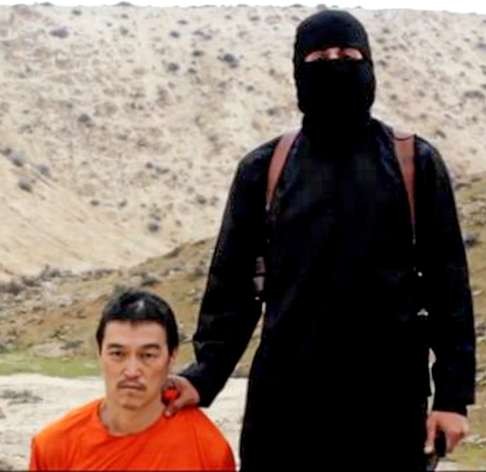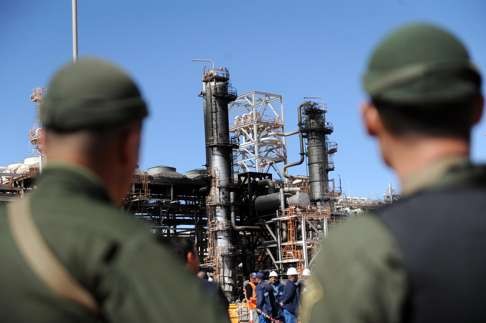
With caskets draped in white sheets, the bitter reality of terror attack arrives home in Japan
The Japanese government has found no easy answers to tackling the threat of terrorism after attack in Dhaka left seven of its citizens dead
Under grey skies, the bodies of the seven Japanese killed in a militant attack in Bangladesh have returned to home soil.
A Japanese government plane carrying the victims’ remains and bereaved family members landed in Tokyo early Tuesday after a gruesome attack by militants on an upscale restaurant in Bangladesh’s capital left 28 dead, including many foreigners.
Their coffins, draped in white sheets, were lowered to the tarmac at Tokyo’s Haneda Airport, where Japanese Foreign Minister Fumio Kishida along with other government officials and colleagues of the victims awaited.

Kishida joined others to offer floral tributes and bowed deeply as they held a moment of silence before the coffins.
“As I received them at the airport, I felt a renewed sense of deep sorrow and anger,” Kishida later told reporters in Tokyo.
“Our country will further coordinate our efforts with the international community so that a tragedy like this will not be repeated.”

The victims were Makoto Okamura, 32, Yuko Sakai, 42, and Rui Shimodaira, 27, all of whom worked for Tokyo-based construction consulting company Almec Corp.; Hideki Hashimoto, 65, Nobuhiro Kurosaki, 48, and Hiroshi Tanaka, 80, who worked for Tokyo-based consulting firm Oriental Consultants Global Co.; and Koyo Ogasawara, 56, an employee of Katahira & Engineers International.
The plane arrived roughly two hours after a small jet carrying injured Tamaoki Watanabe, a Japanese survivor of the siege, landed at Haneda.
He was carried on a stretcher and rushed to hospital for further treatment. He was in a stable condition, according to local media.
The Japanese nationals had been engaged in development projects in Bangladesh with the government-run Japan International Cooperation Agency (JICA).

Japanese officials who returned from Dhaka along with the bereaved families briefed cabinet ministers on the situation.
Also in the morning, the government held a meeting of Cabinet ministers to discuss the case, at which Prime Minister Shinzo Abe said Japan will not yield to terrorism and pledged to implement anti-terrorism measures in the country.
“Our country will not give in to terrorism. We will coordinate moves with the international community to eradicate terrorism,” he said.

But with the attack still fresh in peoples’ minds the remark fell short on persuasiveness.
A Japanese source pointed out that during the Algerian hostage crisis the Japanese government failed to sufficiently share information provided by private companies and other entities.
This led to the formations of the National Security Council that handles crisis management and the International Counter-Terrorism Intelligence Collection Unit charged with intelligence gathering on global militant groups.
After the murder of freelance journalist Kenji Goto, who had been held hostage by Islamic State, a government inspection committee stated in a report released in May 2015 the importance of “accurately analysing and using information that has been collected.”

It further urged “the necessity to work toward improving intelligence gathering, the aggregation of information, and enhancing the powers of analysis.”
But whether lessons have been learned in the most recent attack is the big question.
As was the case in the Algerian hostage crisis, the Japanese government dispatched a special plane to retrieve the bodies of the seven victims and one Japanese survivor of the attack.
“We’ve been reminded that we never know when or where a terrorist attack will happen,” said one high-ranking official from the Foreign Ministry.

Defence Minister Gen Nakatani said: “We have no defence attache in Bangladesh. I feel there is a need for more intelligence gathering on militants amid the sharp increase in terrorism,” suggesting the possibility of examining new measures or working together with neighbouring countries to combat terrorist threats.
Japan is limited in what it can do alone to collect and analyse intelligence on terrorism abroad, and cooperation with other countries concerned is key.
Abe held telephone talks Monday night with his Italian counterpart Matteo Renzi to discuss global cooperation to fight terrorism, the Japanese foreign ministry said.
The Dhaka attack also killed nine Italians as well as a US citizen and a 19-year-old Indian student.
The two leaders agreed that they will use an upcoming round of the Asia-Europe Meeting (ASEM) in Mongolia to issue a clear message against terrorism, the ministry said in a brief statement.
Additional reporting by Associated Press and Kyodo

.png?itok=arIb17P0)